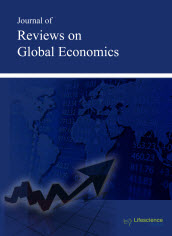jrge
Abstract - Financial Development and Income Inequality in the Selected Southern African Development Community Countries
|
|
Abstract: Financial development is widely regarded as another conduit through which income inequality can be reduced. The study empirically examines the relationship between financial development and income inequality in selected Southern African Development Community (SADC) countries, employing the Generalised Method of Moments technique for the period 1980 to 2016. Based on the inequality-decreasing hypothesis, a model which links financial sector development and inequality was estimated. Empirical results revealed that financial sector development overall does have an impact on income inequality in the selected SADC countries. An interesting observation from the empirical results is that the actual dimension of financial development plays a significant role in determining the relationship between financial development and income inequality in the SADC region. The impact of financial depth on income inequality is not obvious in the study, depending on the variable used. On the relationship between financial system stability and income inequality, results reveal that a stable financial system is beneficial to the poor. Financial efficiency does not appear to have a significant role in reducing income inequality in the selected SADC countries. The findings imply that a specific approach to financial sector development rather than a blanket approach is desirable. Keywords: Financial sector development, income inequality, SADC, GMM. |
Abstract - Influence of Perceived Time and Entrepreneurial Skills Constraints on Entrepreneurship Interest among Final Year Undergraduate and Honours Students at the University of Fort Hare
|
|
Abstract: Several scholarly efforts have been previously exerted in investigating student entrepreneurship interest in the developed countries, and several studies have contributed in this direction, yet little was achieved in South Africa. The main aim of this study was to empirically assess perceived time and entrepreneurial skills constraints as possible barriers to entrepreneurial interest among a sample of 366 (205 (56%) male and 161 (46%) female) final year undergraduate and postgraduate ‘honours’ students of a previously disadvantaged university in the Eastern Cape Province of South Africa, using the survey research design, and a structured validated questionnaire. Three hypotheses were stated and tested using Multiple Regression Analysis. The results revealed that perceived time and entrepreneurial skills constraints jointly influenced entrepreneurship interest, F (2, 363) = 25.887; R2 = 0.120; p<. 01. The results further revealed that perceived time constraint independently influenced entrepreneurship interest, (β = 0.226; t= 4.108; p< .01). Likewise, the results showed that entrepreneurial skills constraint independently influenced entrepreneurship interest, (β = 0.188; t= 3.415; p< .01). The findings are valuable to the policy makers and professionals in promoting the spirit of entrepreneurship among the youth, with the consequence decline rate of joblessness. Keywords: Entrepreneurship interest, entrepreneurial skills constraint, perceived time constraint, university students, South Africa. |
Abstract - The Risk of Nanotechnology: A Challenge to the Insurance Industry
|
|
Abstract: Nanotechnology poses a challenge for the modern man. Aside from the many benefits that nanotechnological growth may bring, it exposes our civilization to an increasing number of new risks, creating hazards that are currently difficult to foresee. Nanotechnological developments may have a negative impact on the natural environment; some researchers claim that they may even jeopardize the very existence of humankind. Existence of defined threats opens up space for the functioning of insurance. Answering the need for nanotechnological risk management, the insurance sector should develop a strategy that would offer a reduction of risk aversion (especially among producers) and augment further development of nanotechnology-based production methods. However, this leads to questions whether nanotechnology-related risk is an insurable risk and whether it is technically feasible at this time to draft such an insurance offer. The present publication attempts to answer these questions. Keywords: Nanotechnology, risk of nanotechnology, insurable risk, insurance industry, mutual insurance. |
Abstract - Modelling the Dynamic Impact of Replanting Subsidy on Tea Production in Sri Lanka: Policy Analysis Using the ARDL Model Approach
|
|
Abstract: The tea industry in Sri Lanka plays a vital role in the economy with its direct and indirect contribution to the gross domestic products, employment, and foreign exchange earnings. The successive governments have introduced subsidy schemes for replanting to increase tea production. However, according to the authors' knowledge, there are no comprehensive quantitative studies undertaken to effectively investigate and quantify the effect of tea replanting subsidy scheme on tea production of the various geographic elevations of tea cultivating lands. The significant contribution of this paper is the quantification of the impact of tea replanting subsidy schemes on tea production in the short-run and long-run at different altitudes. This research takes time series data from 1970 to 2018 of three different heights or elevations-high, medium, and low. The Autoregressive Distributed Lag (ARDL) Model examines the short-run and long-run dynamics of the subsidy scheme on tea production. The results reveal that there is a cointegration between tea production and three variables; tea replanting subsidy, tea prices and tea bearing area; in all three elevations. But tea replanting subsidy is not significant in long run for all three elevations, separately. In the short-run analysis, the impact of replanting subsidy is significant only for tea production in low heights with one-year time lag. Since the study reveals that tea replanting subsidy increases, the tea production of low elevation also increases, and almost 60% of the tea extent and 73% of the total tea production gained from low heights, we recommend that the government continue the tea replanting subsidy schemes as it is benefitted by whole tea industry in long run. Keywords: ARDL Approach, Cost of Production, Tea Production, Tea Prices, Tea Replanting Subsidy, Sri Lanka. |






















